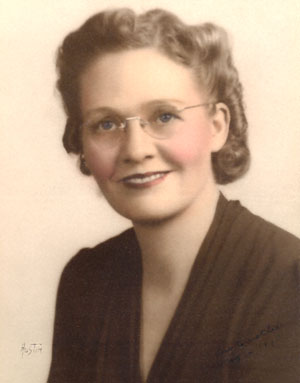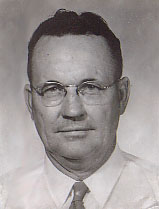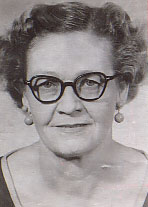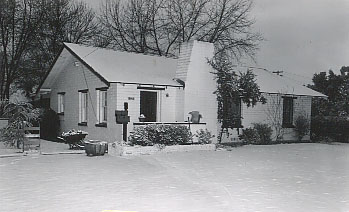Josephine Nielsen Spilsbury Josephine Nielsen Spilsbury was born December 23, 1902, receiving a baby blessing the first Sunday in February 1903 in Colonia Dublan, Chihuahua, Mexico. She was the ninth child of the eleven children born to Carl Emil Nielsen and Jensine Oline Jensen Nielsen. Her parents were Danish citizens, who were converted to The Church of Jesus Christ of Latter-day Saints in Denmark. Carl and Sine came to Utah at an early age before their parents were able to come. After their marriage they moved in 1892 to Colonia Juarez [one of the Mormon colonies] in the state of Chihuahua, Mexico. The Grits mill, which Carl Emil had built in Dublan and was the family income, burned down in 1902. Carl need to work to support his large family, so he took Jensine, and the children at home, and moved to Chihuahua City, to be Plant Foreman for an American lumber company. "Josephine's sister Edith recalled that when Josephine was seven months old she took whooping cough. Mother, thinking she was dying, began to cry. She was so tired and discouraged, and she felt so alone. She was away from all her friends and relatives and couldn't even speak with her neighbors because they all spoke Spanish. She said her faith was all gone; she knew her baby was dying. Josephine's older brother Carl, then about thirteen years old, came in and saw Mother crying over the baby. He left the room for a few minutes; Mother found out later that he was in the other room praying. When he returned, he asked if the baby was better. Mother said no, she couldn't see any change. "Oh I wish Papa would come and administer to her," cried Carl. "Carl," replied Mother, "Papa isn't here, and we can't get him until night, but you can pray. Your prayers will be heard just as soon as the administration will." Carl immediately knelt down in the room and prayed again. Again he asked if the baby was better, and again mother answered no. "Mama, have more faith," pleaded Carl. "She is going to get well, I know she is." It wasn't long before Mother could see a change in the baby. She was getting better but still suffered terrible pain all night. Father and Mother wondered if their faith and Carl's faith were keeping her on Earth when she should have gone. Father again blessed her and told Heavenly Father they were willing to submit to His will; if He wanted the baby they would give her up. But "if her time hadn't come, please bless her and relieve her of her awful suffering." Immediately she went to sleep; her suffering ceased. From then on she gradually improved until she was well." Copied from "Life sketch of my Father, Carl E.Nielsen and Family " by Edith Nielsen Farnsworth The family lived in Chihuahua for a year, then to Juarez [by El Paso] then back to Dublan. Father worked where he could and in 1905 the families moved to Colonia Garcia to farm and work in the American lumber mills at Madera. [Madera was about 60-80 miles ftom Garcia] Josephine was baptized on May 14, 1911, in Madera, Chihuahua, Mexico, by Lester B. Farnsworth and was confirmed a member of The Church of Jesus Christ of Latter-day Saints by her father the same day. Josephine was 10 years old when the Mexican revolution forced all of the Americans out of the colonies. " July 24, 1912, the entire town of Garcia left together. Not everyone was able to secure a wagon so we had to double up not giving us too much room. We were allowed to take a trunk, bedrolls and a lunch. We reached Pearson, Mexico that evening, slept in empty company houses and the train the next morning. We reached El Paso, Texas in the evening a little before sunset. We were met at the depot with autos and taken to a large lumberyard that was practically empty of lumber, where each family was given a section or a small corner. The bedding was rolled out on the ground at night, or in the loft of the yard, wherever we could. Sheets or blankets were hung up for privacy. The bedding was rolled up through the day. Cooking was done by a few, taking turns, then each family would go to the cooks corner where a large stove or stoves were put and get what their family needed and go back to their own corner or section to eat. The food was provided by the U.S. Govt. To me seems we ate mostly potatoes, beans, sardines, salmon and canned corn, for which we were grateful but could not stand to eat sardines again. The army finally provided tents. I think we spent about two weeks there. Father was with us. As he was one of the older men he was sent out to help the women and children. The rest of the men were left to take care of the cattle. Mother and the younger girls moved to Blue Water, New Mexico because her older married children had moved there. Father had gone back in to Mexico to take care of the U.S. interest in Durango. We lived there until Sept. 1913 and then moved to Pima, Arizona." Fxcerpt taken from the remembrances of Venus Nielsen Cluff From 1912 to 1917, she attended elementary schools in New Mexico and Arizona and then returned with her family to the Mexican colonies. She completed her high school education at the Juarez Stake Academy (now called Academia Judrez) in 1923. While at the Juarez Stake Academy, her beautiful singing voice was developed under the training of Reed Gammell, himself a fine tenor. She took part in a number of musicals at the school, culminating in her selection as one of the principal soloists in "The Bohemian Girl," a light grand opera. She found out later that her mother, Jensine, helped pay for her music lessons by doing laundry work. She won the oratorical contest in her senior year and received an autographed book from President Heber J. Grant, President of The Church of Jesus Christ of Latter-day Saints. She was the valedictorian of her graduating class. She used her musical talent generously in church music and funeral services. " P.D. Spilsbury was getting serious with vivacious and talented Josephine Nielsen. They were singing together in choruses, taking leading parts together in operas, and with others becoming popular entertainers on their own. When P.D. was a prominent JSA graduate in 1922, she was a senior. Mother Jane was not surprised when on Josephine's birthday, December 23, 1922 they were quietly married in Garcia where Jo's parents were living. P.D. moved Josephine in his Mother's home, It was a secret dream of both to be married in the Temple. James E. Talmage blessed them that if they were faithful, it would surely be realized. P.D. helped take care of a fruit orchard, and when the crop was harvested and paid off in silver dollars he carried the money home and dumped it on the bed beside Josephine, lying temporarily ill. "There is our Temple trip," sobbed Jo, at once overcome with the speedy fulfillment of a promise. With a little life stirring with in her, she, P.D. her Mother [Jensine] and Mother Jane piled into a jalopy Ford, and traveled to St. George." Excerpts from "Mother Jane's Story" page 223-224 Duane was born August 30, 1924. The marriage was solemnized in the LDS Temple in St. George, Utah. The records state that Josephine received her endowments April 15, 1924. 1 am assuming that was the day that She and P.D. were sealed in the St. George Temple.
Two children were born to the union. Their son Duane [also named Porfirio Diaz] was born in August 30, 1924 in Colonia Juarez and Mother Jane wrote she was present. Duane gained an excellent education and worked as a writer, public information officer, and journalism professor at California State University, Sacramento. The second child, Betty Jo, was born in Tucson, Arizona and died on March 10, 1929. She lived only a few hours. She is buried in the L.D.S. Binghamton cemetery in Tucson, Arizona. 1925 they moved to Bixby Arizona where for a time P.D. worked in the copper mines to earn money for his college education. In 1932 he received his Bachelor of Science Degree from the University of Arizona. Jo assisted her husband through the University of Arizona and moved with him to Ames, Iowa, where he earned a master's degree and completed considerable work toward his doctorate degree. In 1933, they moved to St. George, where P.D. was employed at Dixie Junior College and the high school as head of the Agriculture and Mechanical Art Department. Josephine found much use for her singing in church and school organizations there. She was always in demand to sing "The Spirit of Old Dixie," the college pep song. In 1938, her husband was employed as director of Vocational Agriculture at Wasco Union High School. Josephine made many friends among the people of Wasco, particularly among the Future Farmers of Wasco Union High School, and of their wives and families. Jo was very active in the community life of the small town of Wasco. Honorary member of the Wasco FFA Alumni, member of P.E.O., a member of Wasco Woman's Club, and member of the Order of Eastern Star. There was the small branch of the L.D.S. church in Wasco, which Jo faithfully supported and served. Josephine organized a group of colored students who liked to sing and met regularly with them to practice. This group participated in some of the parades sponsored by the Wasco Future Farmers of America (FFA). One member of the FFA sent in Jo's name as a candidate for good neighbor. She was surprised one morning to have an orchid corsage delivered to her door and to hear her name announced over a large Los Angeles radio station as a Good Neighbor. The great love for children, which was so characteristic of her, was lavished on the children of her friends. In September 1948, her son Duane married Patricia Netherton. The three little boys who blessed the union brought joy and comfort to Josephine's heart. Her greatest joy was in their periodic visits from Sacramento to Wasco. In the year 1956, P.D. was invited by the U.S. Dept. of Agriculture to be a consultant for other teachers, as well, as farmers in the country of Caracas, Venezuela. His success in his job at Wasco and the fact that he and Jo were fluent in Spanish were the reasons they invited him. Duane and Patti's baby John was just over one year old and not much trouble, yet was walking everywhere. They lived in Bakersfield and the children were just the ages Jo enjoyed. It was hard for her to go. Jo was also concerned about good medical care in case of a Diabetes emergency. All was well. They stayed nearly a year and had an interesting stay there. Josephine developed diabetes in 1928, but with the aid of insulin and a strict diet she lived another thirty-eight years, until her heart weakened. Her death brought an end to a marriage of forty-three years. Her radiant personality and capacity to make and keep friends spread sunshine and happiness among those who knew and loved her. Aunt Jo was an Elect Lady. We do not know who wrote the original Biography, however through reading old letters and life stories of the other sisters and things Patti and I remembered, we have added information to clarify some of the events in Jo's life. ajce Memories of Jo Nielsen Spilsbury: [Nena] My name is Patti, one of the luckiest of women because Jo Spilsbury was my Mother in Law. We respected and loved one another. As I am a life long Episcopalian, she may not have been happy that her son Duane chose me to be his wife, but she didn't tell me of her disappointment. Instead, she taught me the values, information and admiration for the LDS faith. When I came to CA. in August 1948 with my Mother and little sister, I was engaged to marry Duane in September and then go with him to begin his graduate work at Stanford University. Jo and PD began our friendship with an invitation to visit Sequoia National Park for a picnic. The feast included fried chicken, salads, her famous sandwiches and cakes. This started the years of my admiration for Jo's cooking. She told us of her experience in St George when PD was teaching at Dixie College, and she was hired at a job to make dozens of sandwiches in early morning. Jo enjoyed cooking for our family and we all well remember the Danish hotcakes and the homemade bread, made with a little bacon drippings for more flavor. Her lovely meals came regularly for all of us but she could not have much of them because of her Diabetes. She and PD built most of their house, first making the adobe bricks from soil on the property. The house included beautiful hardwood floors of which she was very proud She also made the most beautiful braided rugs for each room of her house. Made from woolen remnants they were very thick and lasted for years. One year we all went fishing on Hat Creek north of Redding CA. It was on a cattle ranch where PD purchased calves for his FFA students at the Agriculture Dept of Wasco High School. Around the campfire Jo and PD sang many songs from the days in Mexico and Jo taught my children many songs of childhood which include hand motions. I teach the same songs to my great grandchildren now. Jo would take my sons Paul, Chris and John to the school farm to swim in the reservoir and taught each one how to drive; Her car was a 1959 Plymouth with huge fins. Both Jo and PD loved to have the children come to visit any time and stay as long as possible. Jo loved to sew and made many dresses for me and also countless shirts for our 3 sons as they grew up.
Perhaps Jo's greatest gift to my family was to show us all, by her example, how to handle Diabetes. Duane developed the disease at age 58 and Chris; our middle son began treatment for it at age 47. The attitude which she passed on was to handle it without complaint, to take care of it yourself in choosing foods, give your own shots of insulin, control your weight, test your blood sugar regularly to be stabilized, and get on with a happy life without making your family worry about you. What a blessing that has been to us all. We have missed Jo for many years. She died when Paul and Chris were in High School and John was 10 years old, but they remembered her well with great affection and we tell stories now to our extended families about all the good times we had with Nena and Granddad. It has been a pleasure to gather a few memories to include in the Nielsen family story. Written by Olive Patricia Netherton Spilsbury: Porfirio Duane's wife.
AUNT JO By Alice Jo Cluff Ellsworth Duane Spilsbury is my cousin, son of my mother's sister, Aunt Jo. Duane and I were the only children in our families, and as I had no sisters or brothers, I chose my cousins as my siblings. Consequently, I consider Duane as a brother. Aunt Jo and Mother [Clea] were very close. I was named after Mother's two sisters, Alice and Josephine. When I was a little girl of about two or three years of age, my mother was very ill and the doctor said she would not recover. Arrangements were made for me to be Aunt Jo's little girl. Through blessings for health, my mother recovered, but I was always kind of considered Aunt Jo's girl. Mother and I would make trips to visit with Aunt Jo, P.D., and Duane. Aunt Jo would come and visit us. When I was twelve years old, I spent most of the summer in Wasco, California. Aunt Jo made my school clothes and introduced me to good friends, and I had a wonderful time. Duane and I had water fights in the kitchen I now think I must have been a pest, but that was what I thought kid sisters did. Aunt Jo taught me how to be more ladylike. Through the years Aunt Jo made me blouses, etc., and mailed them to me. She came to Mesa for my wedding. Mother, Aunt Jo, and I shopped together in Phoenix to buy material to sew my trousseau. We attended the bridal showers together. Aunt Jo prepared the wedding dinner. When my children were born she sent presents and remembered birthdays. When visiting Mother in Mesa, she would take me shopping. You can understand I felt very close to Aunt Jo. Duane and Patti were married and Aunt Jo thought they were perfect. She would tell us how concerned she was for them with their young sons and trying to make ends meet while going to school. I always had a lot of love and respect for Pattie and Duane. However, this story is to be about Duane and his name Porfirio. I must give earlier history of his ancestors to tell my story. Duane's parents and grandparents were, pioneers, not only because of their religious belief, but also through their efforts of colonizing through the Rocky Mountains of the United States and down into the northern part of Chihuahua, Mexico. Duane's grandparents, Alma and Mary Jane Redd Spilsbury, were living in Mesa, Arizona, until they left for Mexico in 1891. Duane's father, Porfirio Diaz, was born in 1901 on the Palo Quemado Ranch (eight miles out on the San Diego Flat, located halfway between Hurst's sawmill on top of the mountain and Terrazzo at the end of the railroad track). Duane's mother, Josephine Nielsen, was born in Dublan, Mexico, in 1902. Duane was born August 31, 1924, in Colonia Juarez, Mexico. He was christened Porfirio Duane Spilsbury. Where did the name Porfirio come from? In the year 1885 the Mormons started arriving in Mexico to colonize. Scouts were looking for land to purchase that had clear deeds. Some of the local Mexican officers in the state of Chihuahua became concerned, ordered them out of Mexico and back to the United States, and told them never to return. As General Fuero said, "Americans colonizing on Mexican lands have already cost us the state of Texas." The officers softened and allowed the settlers to have papers written by a Mexican lawyer sent to the president of Mexico, Presidente Porfirio Diaz. President Diaz had respect for the Mormons. The end. ajce This poem was written by Clea (Marcheta, pronounced "mar-KEE-tuh") to Josephine: Dear Jo, through the intervening years This one thing I beseech That we shall always be so near, That either one can reach. Across the sum of little things, That strews the passing days Some time to touch the other's hand Along our divers ways. For it would bruise the heart too much If one of us should call And find the other could not climb Across a slow grown wall. Darling Jo, the gift is small, but all my love comes with it. I hope this day will be so happy you can never forget it. Marcheta [Clea was always called Mar-kee-tuh do not understand why the spelling was incorrect] This is a transcription of a birthday card sent by Josephine to her younger sister Clea. Clea's nickname was "Marcheta." The note shows how much Aunt Jo liked to sew and loved to make things for her family. Aunt Jo was close to all of her sisters. There were only five years between Jo and "Marcheta," and they were especially close: Darling Marcheta Happy Birthday!! Wish I could spend the day with you & bake you a cake. I will be thinking of you and wishing you every good thing that your heart desires! I'm making you a summer short robe. I'm afraid I won't have it finished in time to reach you by Fri. so I'll tell you about it and send it as soon as I can. It is of pink checked gingham. It hangs from the shoulder with no belt. I tried to make it cool for the hot summer. Then in the fall I'll make you another nylon one. It isn't much but every stitch is made with love. I hope it fits. I do love you very much and you know I like you too. You're a pretty nice person for my money. Love, Jo A letter Josephine wrote to her older Sister Vennus. It shows the love that the sisters had for each other and the desire to help. Archie, Vennus's husband, died April 20,1936 in Pima, Arizona. He had come out from Col. Juarez to see a Docter. Aunt Vermus came out, with a group, a few days latter to go to the temple in Mesa. When she learned how ill Archie was, she was able to be with him before he died of a ruptured ulcer. Aunt Vennus was forty-two years old and left with ten children ages 2 years through about 18 years old. Darling Vennus, P.D. just brought me Aunt Andrea's card Oh Vennus, I love you so dearly. You're so kind and generous and good. Surely the Lord will bless and comfort you in this time of heartache, and Archie was so good and kind. I remember a trip we took to Mexico just before we went to Ames. Archie was dancing with me and he told me how glad he was that he belonged to our family, that he thought ours was such a grand family. But I know one thing, while some of the family are pretty grand, as grand as he was, (I'm not. If I live to be a million years old I'll never be as big and good as Archie. Darling Sister, I wish I could send you enough money that you would never need again. I'm sending 3 dollars, and I know that isn't enough to do any good, but maybe you would like to get some flowers or cloth for yourself a dress. Will you be in Pima long enough for me to send a parcel? Let me know. One of the children can write me. I'll be so anxious to hear from you. My love to you darling Vennus and to the children. Jo, P.D., and Duane It is interesting how important $3.00 was in 1936. P.D. is Josephine's husband. His parents named him Profirio Diaz; he later had his named changed to Paul Duane. ajce .The End |




